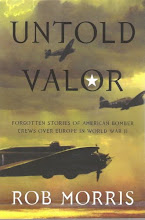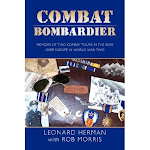
Maurice's Graduation Photo from Bombardier School, stateside, before going overseas.
Maurice Rockett is a close friend who lives in Massachusetts. One summer, while visiting with him and his charming wife Grace at his home, he told me about a forgotten side of the air war. There were many airmen--and soldiers in the infantry and cavalry--who received horrendous wounds in combat. For them, the day of their wound became only the first of a lifetime of days in physical and mental anguish. It is fitting to remember this now, as we have many soldiers returning from Iraq and Afghanistan with the same types of maiming. These men and women deserve the best medical care our nation can give them. Anything less is an outrage.
The flak with Maurice's name on it came calling on April 29, 1944. In a chapter he calls 'Lights out for me' , Maurice describes a mission with the 95th Bomb Group to bomb Berlin. Just west of Berlin, after surviving heavy fighter attack, the group encountered flak. Flak and shards of the Plexiglass nose exploded into Maurice's bombardier compartment, slicing into his eyes and face. The incredible percussion of the flak burst so close to the plane spun him around. The plane fell out of formation, and Maurice, blinded, considered the terrible possibility of having to bail out and land on enemy soil without his sight. The plane managed to limp back to base, and Maurice was rushed to a special field hospital staffed by experts from Duke University, reserved for the most serious cases. The surgeon operated on his right eye, stitching a portion of his upper eyeball to the center of the eye. Eventually, the eye was removed. Maurice now wears a prosthetic eyeball.
He was then laid on a bed between two towel-covered cinderblocks. "Nobody told me anything," he remembers. "There was a chance that I was blind. When they finally took the bandages off, I could see some hazy light out of my left eye. My spirits soared. Oh, happy day!"
In the hospital, "patients moaned, screamed, or cried during the night. I had only one visitor from the 95th, my friendly navigator. They did not want me back on the base as one of the walking wounded. This would not go well with combatants who had enough on their minds."
Shortly after D-Day, the hospital began to fill with wounded from the invasion. "Most of them had on combat clothing, salt water, and were partially sand-covered from beach areas."
On July 3, Maurice flew home by way of Prestwick, Scotland, Iceland and Newfoundland, landing in New York. After a short stay in a New York hospital, he was transfered again, this time to Valley Forge Hospital in Phonexville, PA. This hospital specialized in serious eye cases, plastic surgery, and mental illness.
"Most of the serious cases did not want to be out in public," Maurice remembers. "They only wanted to be around those vets who understood their problems...Among the patients was every type of wound. Both air and tank crews suffered terrible burns. Many had no ears, nose, arms, legs, or combinations thereof. The really bad cases were housed in seperate rooms out of sight. I hope most of them became whole again and, if they did, it would be a long, tortuous road to recovery."
"We often relate to the dead in war, but seldom to our deserving wounded."
Lest we forget them, then or now.
In a bizarre footnote, Maurice had a photograph taken in England, and mailed it home to his family. Before the photo arrived, he was wounded in the right eye. When the photo arrived, it had a deep crease that ran directly through his right eye, the same one he had lost while the photo was in transit.







No comments:
Post a Comment